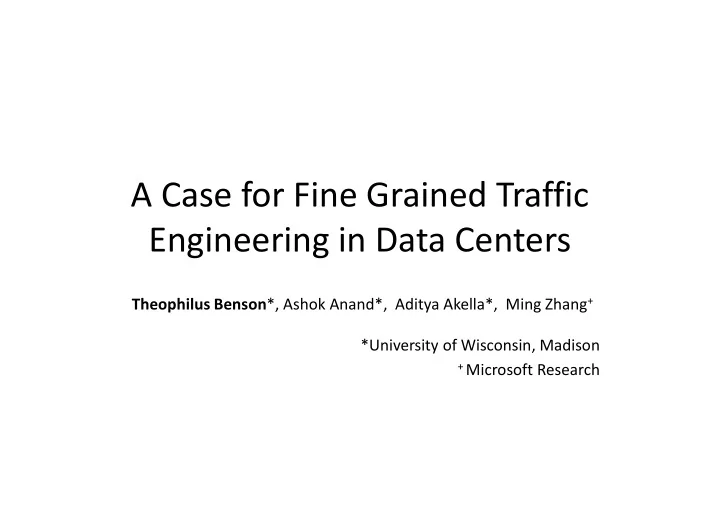

A Case for Fine Grained Traffic Engineering in Data Centers Engineering in Data Centers Theophilus Benson *, Ashok Anand*, Aditya Akella*, Ming Zhang + *University of Wisconsin, Madison + Microsoft Research
Why are Data Centers Important? • Congestion == bad app. performance • IM: low B/W, loose latency • Bad app performance == user dissatisfaction • Multimedia: low B/W, strict latency • User dissatisfaction == loss of revenue • Games: high B/W, strict latency • Traffic engineering is crucial
Outline • Background • Traffic Engineering in data centers • Design goals for ideal TE • MicroTE • MicroTE • Conclusion
Options for TE in Data Centers? • Current supported techniques – Equal Cost MultiPath (ECMP) – Spanning Tree Protocol (STP) • Proposed (ECMP based) • Proposed (ECMP based) – Fat-Tree, VL2 • Other existing – TEXCP, COPE,…, OSPF link tuning
Properties of Data Center Traffic • Flows are small and short-lived [Kandula et. al, 2009] • Traffic is bursty [Benson et. al, 2009] • Traffic is unpredictable at 100 secs [Maltz et. al, 2009]
How do we evaluate TE? • Data center traces – Cloud data center …. • Map-reduce app • ~1500 servers, • ~80 switches • 1 sec snapshots for 24 hours • Simulator – Input: • Traffic matrix, Topology ,Traffic Engineering – Output: • link utilization
Draw Backs of Existing TE • STP does not use multiple path • ECMP does not adapt to burstiness
Draw Backs of Proposed TE • Fat-Tree – Rehash flows – Local opt. != global opt. • VL2 – Coarse grained flow assignment • VL2 & Fat-Tree do not adapt to burstiness
Draw Backs of Other Approaches • TEXCP, COPE …. OSPF link tuning ������� �������� x • Unable to react fast enough (below 100 secs)
Design Requirements for TE • Calculate paths & reconfigure network – Use all network paths – Use global view – Must react quickly …. • How predictable is traffic?
Is Data Center Traffic Predictable? • YES! 33% of traffic is predictable
How Long is Traffic Predictable? • TE must react in under 2 seconds
MicroTE: Architecture Monitoring Component Routing Component …. …. Network Controller • Based on OpenFlow framework • Global view: • created by network controller • React to predictable traffic: routing component tracks demand history • • All N/W paths: • routing component creates routes using all paths
Routing Component • Step 1: Determine predictable traffic • Step 2: Route along rarely utilized paths – Currently use LP – Faster Algorithm == future work – Faster Algorithm == future work • Step 3: Set ECMP for other traffic • Step 4: Return routes
Routing Component New Global View Determine Predictable ToRs Now: Use LP Future: Use heuristic Calculate Network Routes for predictable traffic predictable traffic Set ECMP for unpredictable traffic Add Network View to History Yes No Significant Change in Routes? Return Nothing Return Calculated Routes
Tradeoffs: Monitoring Component Routing Monitoring Component Component Network Controller …. …. • Switch based • End-host based – Low complexity – Low overhead – High overhead – High complexity
Preliminary Evaluation • Outperforms ECMP • Slightly worse than optimal
Conclusion • Study existing TE – Found them lacking (15-20%) • Study data center traffic – Discovered traffic predictability (33% for 2 secs) – Discovered traffic predictability (33% for 2 secs) • Guidelines for ideal TE • MicroTE – Implementation of ideal TE – Preliminary evaluation
Thank You • Questions?
Recommend
More recommend